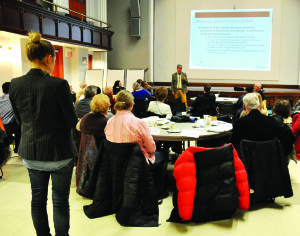Dennis Hanagan –

Glen Murray addresses audience at St. Paul’s.
Toronto Centre residents have given their MPP Glen Murray an earful about how Toronto’s planning process can be made better so that neighbourhoods get development they want, not so much what large-scale developers want.
As it stands, Toronto’s planning staff can advise councillors against approving a proposed development, but the developer can appeal to the Ontario Municipal Board (OMB). That body—which is known for often ruling in a developer’s favour—has become an irritant to residents and councillors.
Ontario’s municipal and housing affairs ministry is listening to gripes around the province as it conducts a review of land use planning and appeals. Murray has held town hall meetings with constituents in Cabbagetown, Corktown, Church-Wellesley and Rosedale-Moore Park to hear them out.
Toronto’s official plan—which is currently in review—seems to be part of the problem, according to Murray. “We don’t have a current official plan,” Murray said in an interview following a March 10 public meeting at St. Paul’s Anglican Church on Bloor St. E.
“You heard the word by many residents here it’s a guideline. It rarely means that what you see in the plan is what’s going to get built because there’re so many distortions along the way,” said Murray. “People want a plan that isn’t a guideline, that is actually a plan.”
In a telephone interview, Paul Bain, project manager of the official plan review, said the review is required to keep up to date with new provincial legislation. “It’s not a guideline; it is a statutory document.”
The official plan states broadly how Toronto wants to see itself take shape over the years, while zoning bylaws state precisely how tall new development and buildings can be and the density they are allowed to have.
He was at St. Paul’s to present suggestions people have made at the town hall gatherings and to get feedback. Those suggestions were noted in a 7-page summary he handed out.
People want earlier notification when projects are proposed for their neighbourhoods. “Often, the first exposure that an individual may have with the planning process is when they receive a notification in the mail,” says the summary.
Because developers have the finances to hire lawyers and other experts to represent them at the OMB, people have said there should be a means to provide residents groups with basic representation at hearings “at no cost.”
They’d also like to see the city set up “special appeals bodies” that would represent different geographic areas, and they and not the OMB would have the final say in what gets built.
“There should be requirements that prescribe who is eligible to fill specific roles on planning appeal boards … a certain number of panel members should be filled by experts … and a certain number should be from a more general background,” states the summary.
At the meeting, a resident called for a “mechanism” with which residents and developers can get together in the early stages of a proposal to resolve disputes rather than heading to the OMB for a “knock ‘em down and drag ‘em out fight.”
He also said the onus should be on the developer to state why his plan should be accepted and not on residents to argue why it shouldn’t. “The whole system seems to be completely backward,” the man said.
A realtor said the OMB shouldn’t have the right to let a developer off the hook from making a Section 37 payment. “That would solve a lot of problems,” he said.
Under the Planning Act a developer can negotiate greater density for a building and, in return, make a payment to the city for neighbourhood improvements.
According to Murray’s summary, people want a “fixed formula” to determine how much a developer should pay to add extra density to a proposed building.
Another complaint people have about the planning process is the vague term “minor” as it applies to minor variance applications that seek Committee of Adjustment approval.
“Minor isn’t minor,” Murray said in the interview. “It’s often major and it’s often major backdoor rezoning, and minor variances are used to undermine the [official plan] which is why people say it’s often guidelines.”
“If you want good results, if you want want good economic growth, if you want reasonably-scaled neighbourhoods (and) transportation integrated into land use and buildings … you need to have a much more rigourous planning regime,” he said.
 TheBulletin.ca Journal of Downtown Toronto
TheBulletin.ca Journal of Downtown Toronto

